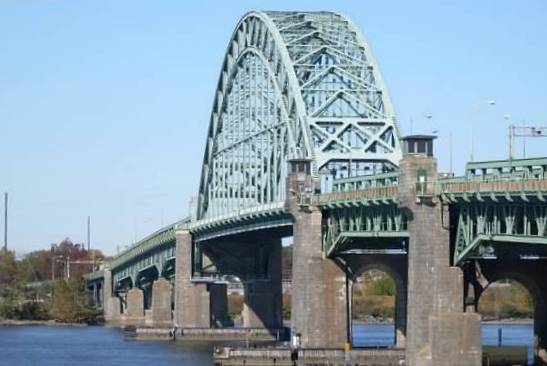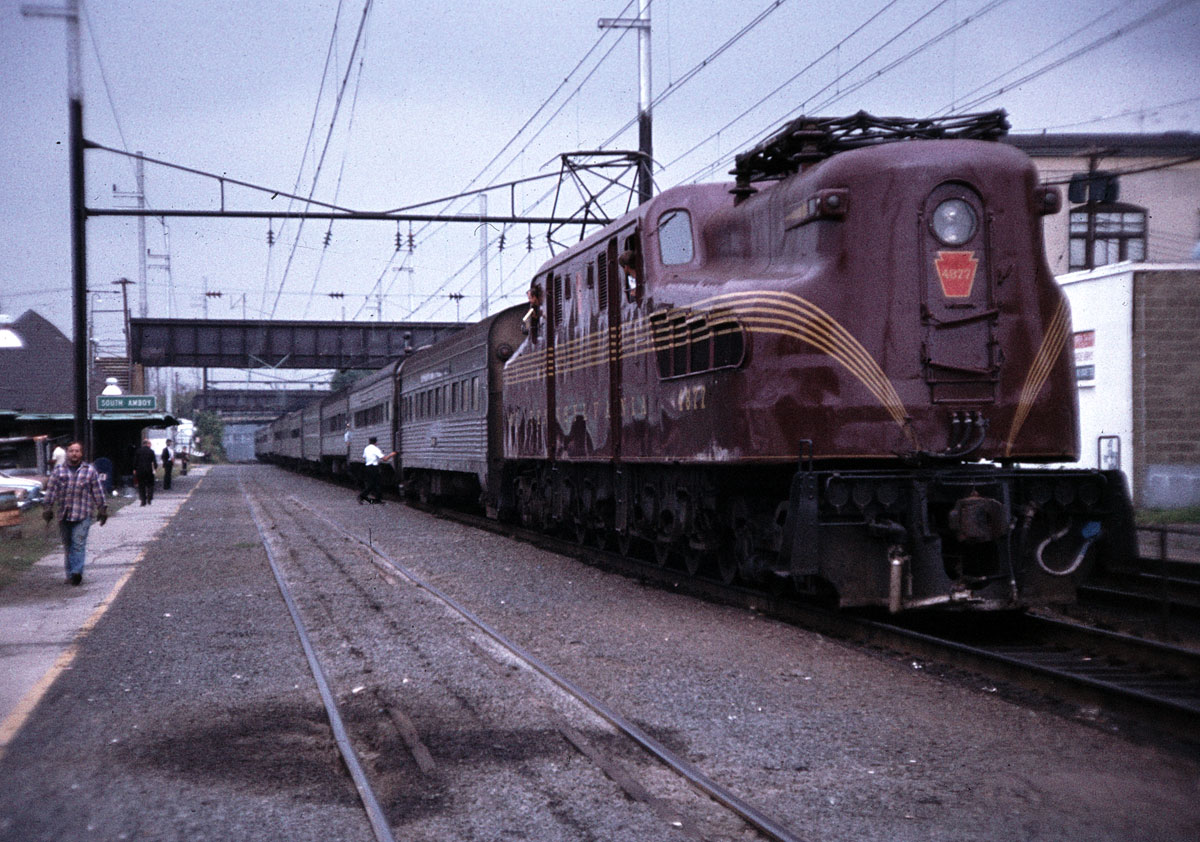|
New Jersey Route 413
Route 413 is a state highway located entirely in the City of Burlington, New Jersey, United States. It is an eastward extension into New Jersey of the longer Pennsylvania Route 413 (PA 413). The western terminus is in the middle of the Burlington–Bristol Bridge crossing of the Delaware River at the New Jersey–Pennsylvania state border; the eastern terminus is at an intersection with U.S. Route 130 (US 130) and County Route 543 (CR 543). Prior to the 1953 renumbering, Route 413 was Route S25, a prefixed spur of Route 25. Route description Route 413 begins at the state line, midway along the vertical-lift Burlington–Bristol Bridge, as a continuation of PA 413. As the road descends from the bridge, a toll booth spans the width of the road though a toll is only collected for westbound traffic. The highway heads eastward, heading along Keim Boulevard, and becomes maintained by Burlington County. For eastbound traffic, a right-in/right-out intersec ... [...More Info...] [...Related Items...] OR: [Wikipedia] [Google] [Baidu] |
Burlington County Bridge Commission
The Burlington County Bridge Commission is a public agency responsible for the operation and maintenance of several bridges in Burlington County, New Jersey, United States, across the Delaware River. It now manages eight bridges, including the Tacony-Palmyra Bridge, the Burlington-Bristol Bridge, and the Riverside-Delanco Bridge. Minor bridges operated by the Commission are the Pennsauken Creek Bridge, Pompeston Creek Bridge, Route 73 Overpass, Swede Run Bridge and the Twin Pipe Culvert, all along County Route 543. Tolls are collected in New Jersey for traffic heading towards Pennsylvania at the Tacony-Palmyra and Burlington-Bristol Bridges. No tolls are collected for traffic crossing into New Jersey. Tolls range from $2.00 for two-axle cars, vans, light pick-up trucks and motorcycles, up to $22.50 for five-axle trucks. E-ZPass is accepted for payment of tolls. Tolls were increased on September 15, 2015. Two-Axle cars are $3.00 with EZPass / $4.00 cash. A total of $51 million ... [...More Info...] [...Related Items...] OR: [Wikipedia] [Google] [Baidu] |
Vertical-lift Bridge
A vertical-lift bridge or just lift bridge is a type of movable bridge in which a span rises vertically while remaining parallel with the deck. The vertical lift offers several benefits over other movable bridges such as the bascule and swing-span bridges. Generally speaking, they cost less to build for longer moveable spans. The counterweights in a vertical lift are only required to be equal to the weight of the deck, whereas bascule bridge counterweights must weigh several times as much as the span being lifted. As a result, heavier materials can be used in the deck, and so this type of bridge is especially suited for heavy railroad use. The biggest disadvantage to the vertical-lift bridge (in comparison with many other designs) is the height restriction for vessels passing under it, due to the deck remaining suspended above the passageway. Although most vertical-lift bridges use towers, each equipped with counterweights, some use hydraulic jacks located below the deck. ... [...More Info...] [...Related Items...] OR: [Wikipedia] [Google] [Baidu] |
State Highways In New Jersey
In the U.S. state of New Jersey, the New Jersey Department of Transportation (NJDOT) maintains a system of state highways. Every significant section of roadway maintained by the state is assigned a number, officially State Highway Route X. Interstate Highways and U.S. Highways are included in the system. State Routes are signed with the circular highway shield. Numbering and other details Major routes are typically assigned one- or two-digit numbers, except where the numbers were chosen to match an adjacent state. Most numbers from 1 to 50 follow a general geographic pattern assigned in 1927 (details below), but later additions are more haphazard. The only suffixed routes other than U.S. Route 9W are short unmarked connections such as Route 76C, an elongated ramp to Interstate 76. The only special state route is Route 33 Business; U.S. Route 1 Business and U.S. Route 1-9 Truck are also present. A statewide system of major county highways is numbered by the NJDOT in the 500- ... [...More Info...] [...Related Items...] OR: [Wikipedia] [Google] [Baidu] |
E-ZPass
E-ZPass is an electronic toll collection system used on toll roads, toll bridges, and toll tunnels in the Eastern United States, Midwestern United States, and Southern United States. The E-ZPass Interagency Group (IAG) consists of member agencies in several states, which use the same technology and allow travelers to use the same transponder on toll roads throughout the network. Since its creation in 1987, various independent systems that use the same technology have been folded into the E-ZPass system, including the I-PASS in Illinois and the NC Quick Pass in North Carolina. Negotiations are ongoing for nationwide interoperability in the United States (see ). Functionality Technology E-ZPass tags are active RFID transponders, historically made by Kapsch#Kapsch TrafficCom AG (KTC), Kapsch TrafficCom (formerly Mark IV Industries Corp—IVHS Division) under a competitively bid contract. They communicate with reader equipment built into lane-based or Open road tolling, o ... [...More Info...] [...Related Items...] OR: [Wikipedia] [Google] [Baidu] |
Concurrency (road)
A concurrency in a road network is an instance of one physical roadway bearing two or more different route numbers. When two roadways share the same right-of-way, it is sometimes called a common section or commons. Other terminology for a concurrency includes overlap, coincidence, duplex (two concurrent routes), triplex (three concurrent routes), multiplex (any number of concurrent routes), dual routing or triple routing. Concurrent numbering can become very common in jurisdictions that allow it. Where multiple routes must pass between a single mountain crossing or over a bridge, or through a major city, it is often economically and practically advantageous for them all to be accommodated on a single physical roadway. In some jurisdictions, however, concurrent numbering is avoided by posting only one route number on highway signs; these routes disappear at the start of the concurrency and reappear when it ends. However, any route that becomes unsigned in the middle of the concurren ... [...More Info...] [...Related Items...] OR: [Wikipedia] [Google] [Baidu] |
Divided Highway
A dual carriageway ( BE) or divided highway ( AE) is a class of highway with carriageways for traffic travelling in opposite directions separated by a central reservation (BrE) or median (AmE). Roads with two or more carriageways which are designed to higher standards with controlled access are generally classed as motorways, freeways, etc., rather than dual carriageways. A road without a central reservation is a single carriageway regardless of the number of lanes. Dual carriageways have improved road traffic safety over single carriageways and typically have higher speed limits as a result. In some places, express lanes and local/collector lanes are used within a local-express-lane system to provide more capacity and to smooth traffic flows for longer-distance travel. History A very early (perhaps the first) example of a dual carriageway was the ''Via Portuensis'', built in the first century by the Roman emperor Claudius between Rome and its port Ostia at the mouth of t ... [...More Info...] [...Related Items...] OR: [Wikipedia] [Google] [Baidu] |
River Line (NJ Transit)
The River Line (stylized as River LINE) is a hybrid rail (light rail with some features similar to commuter rail) line in southern New Jersey that connects the cities of Camden and Trenton, New Jersey's capital. It is so named because its route between the two cities is parallel to the Delaware River. The River Line stops at the PATCO Speedline's Broadway station (Walter Rand Transportation Center) and the NJ Transit Atlantic City Line's Pennsauken Transit Center, providing connections to Philadelphia, Pennsylvania. Its northern terminus is adjacent to the Trenton Transit Center. The line is operated for New Jersey Transit by the Southern New Jersey Rail Group (SNJRG), which originally included Bechtel Group and Bombardier. Now that the project is in its operational phase, Bombardier is the only member of SNJRG. Ridership The River Line is currently exceeding final ridership estimates of 5,500 passengers per day, with an average of 9,014 weekday, 5,922 Saturday, and 4,70 ... [...More Info...] [...Related Items...] OR: [Wikipedia] [Google] [Baidu] |
NJ Transit
New Jersey Transit Corporation, branded as NJ Transit, and often shortened to NJT, is a state-owned public transportation system that serves the U.S. state of New Jersey, along with portions of New York State and Pennsylvania. It operates bus, light rail, and commuter rail services throughout the state, connecting to major commercial and employment centers both within the state and in the adjacent major cities of New York and Philadelphia. In , the system had a ridership of . Covering a service area of , NJT is the largest statewide public transit system and the third-largest provider of bus, rail, and light rail transit by ridership in the United States. NJT also acts as a purchasing agency for many private operators in the state; in particular, buses to serve routes not served by the transit agency. History NJT was founded on July 17, 1979, an offspring of the New Jersey Department of Transportation (NJDOT), mandated by the state government to address many then-pressi ... [...More Info...] [...Related Items...] OR: [Wikipedia] [Google] [Baidu] |
Traffic Circle
A roundabout is a type of circular intersection (road), intersection or junction in which road traffic is permitted to flow in one direction around a central island, and priority is typically given to traffic already in the junction.''The New Shorter Oxford English Dictionary,'' Volume 2, Clarendon Press, Oxford (1993), page 2632 Engineers use the term modern roundabout to refer to junctions installed after 1960 that incorporate various design rules to increase safety. Both modern and non-modern roundabouts, however, may bear street names or be identified colloquially by local names such as rotary or traffic circle. Compared to stop signs, traffic signals, and earlier forms of roundabouts, modern roundabouts reduce the likelihood and severity of collisions greatly by reducing traffic speeds and minimizing Side collision#Broadside or T-bone collision, T-bone and head-on collisions. Variations on the basic concept include integration with tram or train lines, two-way flow, hi ... [...More Info...] [...Related Items...] OR: [Wikipedia] [Google] [Baidu] |
Right-in/right-out
Right-in/right-out (RIRO) and left-in/left-out (LILO) refer to a type of three-way road intersection where turning movements of vehicles are restricted. A RIRO permits only right turns and a LILO permits only left turns. "Right-in" and "left-in" refer to turns from a main road ''into'' an intersection (or a driveway or parcel); "right-out" and "left-out" refer to turns ''from'' an intersection (or a driveway or parcel) to a main road. RIRO is typical when vehicles drive on the right, and LILO is usual where vehicles drive on the left. This is because minor roads usually connect to the outsides of two-way roads. However, on a divided highway, both RIRO and LILO intersections can occur. The remainder of this article refers only to RIRO but applies equally to LILO. A RIRO intersection differs from a 3/4 intersection (right in/right out/left in) and an unrestricted intersection. Design RIRO is an important tool of access management, itself an important component of transport ... [...More Info...] [...Related Items...] OR: [Wikipedia] [Google] [Baidu] |


_1.jpg)



